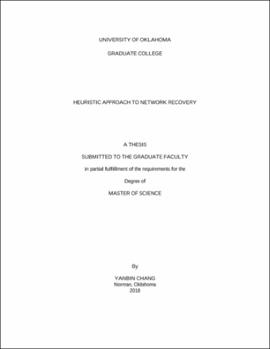| dc.contributor.advisor | Nicholson, Charles | |
| dc.contributor.author | Chang, Yanbin | |
| dc.date.accessioned | 2018-05-11T16:23:51Z | |
| dc.date.available | 2018-05-11T16:23:51Z | |
| dc.date.issued | 2018-05-11 | |
| dc.identifier.uri | https://hdl.handle.net/11244/299893 | |
| dc.description.abstract | This study addresses optimization modeling for recovery of a transportation system after a major disaster. In particular, a novel metric based on the shape of the recovery curve is introduced as the objective to minimize. This metric is computed as the distance from the pre-disaster system performance at a time immediately before disruption to the two-dimensional location of the centroid point of the area beneath the recovery curve. The recovery trajectories derived from optimization models with this new metric are considered along with two other recovery goals from literature, i.e., minimizing the total recovery time and minimizing the skew of the recovery trajectory. A genetic algorithm is implemented to search for optimal restoration schedules under each objective and empirical analysis is used to evaluate the corresponding quality of the solutions. Additionally, a particle swarm optimization algorithm is employed as an alternative metaheuristic and the quality of the recovery schedules, as well as the observed computational efficiency is analyzed. | en_US |
| dc.language | en_US | en_US |
| dc.subject | post-disaster network | en_US |
| dc.subject | Gomory-Hu Tree | en_US |
| dc.subject | centroid of recovery trajectory distance | en_US |
| dc.subject | Genetic algorithms and particle swarm optimization | en_US |
| dc.title | Heuristic Approach to Network Recovery | en_US |
| dc.contributor.committeeMember | Barker, Kash | |
| dc.contributor.committeeMember | Allen, Janet | |
| dc.date.manuscript | 2018-05-10 | |
| dc.thesis.degree | Master of Science | en_US |
| ou.group | College of Engineering::School of Industrial and Systems Engineering | en_US |
| shareok.nativefileaccess | restricted | en_US |
